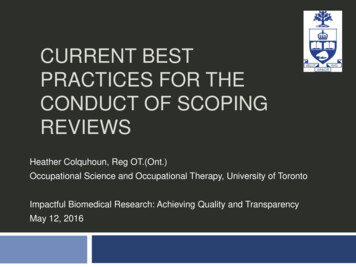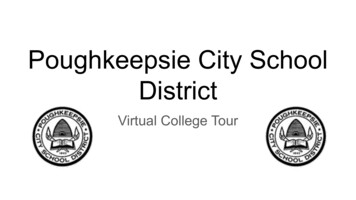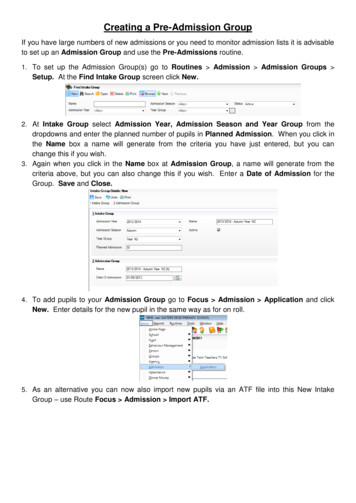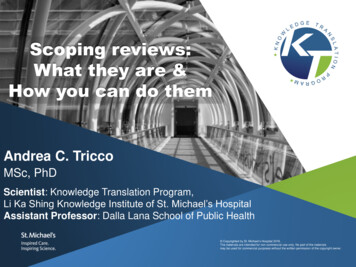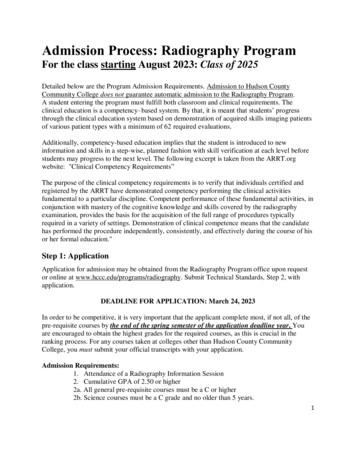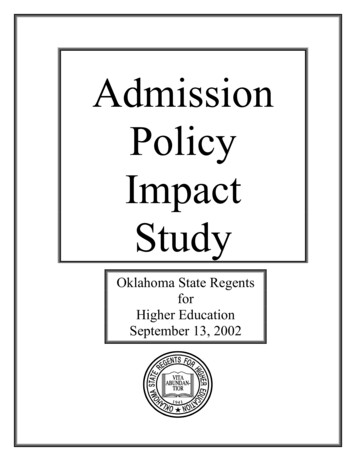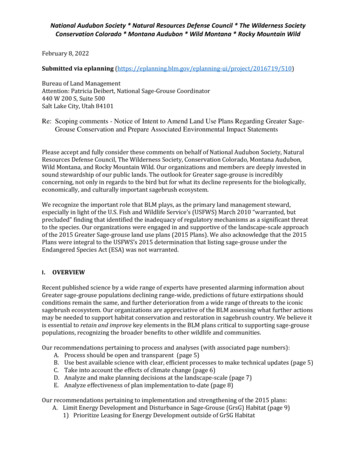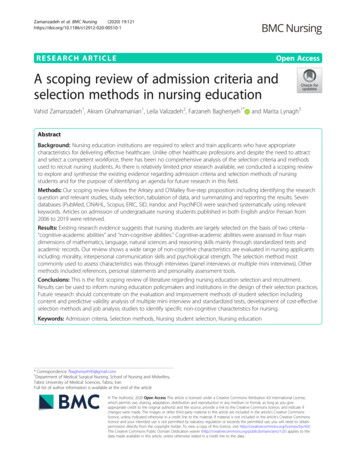
Transcription
Zamanzadeh et al. BMC Nursing(2020) SEARCH ARTICLEOpen AccessA scoping review of admission criteria andselection methods in nursing educationVahid Zamanzadeh1, Akram Ghahramanian1, Leila Valizadeh2, Farzaneh Bagheriyeh1*and Marita Lynagh3AbstractBackground: Nursing education institutions are required to select and train applicants who have appropriatecharacteristics for delivering effective healthcare. Unlike other healthcare professions and despite the need to attractand select a competent workforce, there has been no comprehensive analysis of the selection criteria and methodsused to recruit nursing students. As there is relatively limited prior research available, we conducted a scoping reviewto explore and synthesise the existing evidence regarding admission criteria and selection methods of nursingstudents and for the purpose of identifying an agenda for future research in this field.Methods: Our scoping review follows the Arksey and O’Malley five-step proposition including identifying the researchquestion and relevant studies, study selection, tabulation of data, and summarizing and reporting the results. Sevendatabases (PubMed, CINAHL, Scopus, ERIC, SID, Irandoc and PsycINFO) were searched systematically using relevantkeywords. Articles on admission of undergraduate nursing students published in both English and/or Persian from2006 to 2019 were retrieved.Results: Existing research evidence suggests that nursing students are largely selected on the basis of two criteria “cognitive-academic abilities” and “non-cognitive abilities.” Cognitive-academic abilities were assessed in four maindimensions of mathematics, language, natural sciences and reasoning skills mainly through standardized tests andacademic records. Our review shows a wide range of non-cognitive characteristics are evaluated in nursing applicantsincluding: morality, interpersonal communication skills and psychological strength. The selection method mostcommonly used to assess characteristics was through interviews (panel interviews or multiple mini interviews). Othermethods included references, personal statements and personality assessment tools.Conclusions: This is the first scoping review of literature regarding nursing education selection and recruitment.Results can be used to inform nursing education policymakers and institutions in the design of their selection practices.Future research should concentrate on the evaluation and improvement methods of student selection includingcontent and predictive validity analysis of multiple mini interview and standardized tests, development of cost-effectiveselection methods and job analysis studies to identify specific non-cognitive characteristics for nursing.Keywords: Admission criteria, Selection methods, Nursing student selection, Nursing education* Correspondence: fbagheriyeh95@gmail.com1Department of Medical Surgical Nursing, School of Nursing and Midwifery,Tabriz University of Medical Sciences, Tabriz, IranFull list of author information is available at the end of the article The Author(s). 2020 Open Access This article is licensed under a Creative Commons Attribution 4.0 International License,which permits use, sharing, adaptation, distribution and reproduction in any medium or format, as long as you giveappropriate credit to the original author(s) and the source, provide a link to the Creative Commons licence, and indicate ifchanges were made. The images or other third party material in this article are included in the article's Creative Commonslicence, unless indicated otherwise in a credit line to the material. If material is not included in the article's Creative Commonslicence and your intended use is not permitted by statutory regulation or exceeds the permitted use, you will need to obtainpermission directly from the copyright holder. To view a copy of this licence, visit http://creativecommons.org/licenses/by/4.0/.The Creative Commons Public Domain Dedication waiver ) applies to thedata made available in this article, unless otherwise stated in a credit line to the data.
Zamanzadeh et al. BMC Nursing(2020) 19:121BackgroundStudent selection in the health professions is increasinglybeing recognised as an important issue [1]. The ultimategoal of student selection is to identify who will go on tobe the most effective clinicians in delivering patient care,which ultimately relates to positive health outcomes [2].Selection of students who can successfully completetheir education and have necessary professional qualifications is currently considered a main challenge ofhealth education institutions in the world [3].Nurses, who play a key role in promoting individualand community health [4], comprise the largest group ofhealth care workforce [5] with approximately 35 millionnurses and midwives worldwide. Choosing the right student for the nursing profession will ensure job compatibility, improves nursing workforce performance in thefuture and ensures the safety and well-being of patients[6]. Additionally it maximizes the effectiveness of healthsystems and can ultimately lead to improved nursingcare. It also helps to better the public image of the nursing profession in the society [7].Recently, the number of nursing program applicationshas increased both internationally and in Iran [8, 9]. Oneof the major challenges in the nursing education isselecting competent applicants who are most likely toaccomplish the training program successfully, and makea long-term effective contribution to their profession,the general public, and the community [10]. This issuehas received much attention in recent years, largely dueto growing concerns of diminishing quality of nursingcare, high attrition rates, limited resources and students’academic failure [11–13]. In addition, nursing instructors and educators [14] have reported a rise in unprofessional attitudes and behaviours of nursing students,further demonstrating the need for the assessment ofthe professional skills of applicants to nursing, inaddition to academic performance [7].Selection for nursing education in IranSelection methods for entering the nursing professionis considered a key nursing challenge in Iran. Currently, the fit between nursing applicants’ personalcharacteristics and requirements of the nursing profession are not considered. This has reduced the efficiency of nurses’ performance and impeded thedevelopment and maintenance of a sustained, efficientworkforce [15, 16]. Since the 1980s, the only criterionutilised in Iran has been success in the UniversityEntrance Exam, which takes the format of a multiplechoice written test [17]. A large number of graduatedfrom high school sit the entrance exam annually andadmit different majors based on their ranks in thisexam [18]. This exam caters for all majors, and henceit cannot take specific features and perquisites forPage 2 of 17each profession into account [19], where arguably criteria for the health professions may be different toother disciplines and professions.Several obstacles have impacted the nursing studentadmission system and nursing profession in Iran in recent years. A significant number of high school graduates admitted to nursing schools through the currentsystem leave before completion because of the mismatchbetween their personal traits and those required by thenursing profession or they lack sufficient motivation tobecome qualified nurses [20]. Another important negative effect is reduced efficiency and effectiveness ofnurses in their job duties, which is often attributed tosub-optimal selection. In most cases, failure of individuals to effectively perform their job in the organizationarises from inconsistency of their psychological characteristics with the job they are undertaking rather thanthe lack of technical skills or intelligence [21]. This canlead to reduced satisfaction, job failure [22], increasedjob burnout, decreased performance [21] and reductionof nursing care quality [23].Nursing education institutions are responsible forselecting and training applicants who have the characteristics necessary for developing and transforming the future of the nursing profession [24, 25]. They arerequired to have clear admission policies relating to theselection process and minimum admission criteria [26].However, there is a Lack of information based on research evidence regarding nursing students’ admissioncriteria and selection practices. Given this knowledgegap and the importance of selecting the right candidatesfor entry into the nursing profession, a comprehensiveanalysis of existing research on admission criteria andselection methods of undergraduate nursing studentswas conducted.Objectives and review questionsThis study aimed to review existing research evidenceregarding nursing students’ selection criteria and selection methods. The research questions were:1) What criteria are being used to select applicants?2) Which selection methods are being used to assessapplicants as part of selection into undergraduatenursing students?3) What does the evidence show regarding thepredictive validity of selection methods withstudents’ academic performance?MethodStudy designThis scoping review was conducted based on the PRISMA guidelines (see the supplementary data 1) [27, 28].The five steps included: identifying the research
Zamanzadeh et al. BMC Nursing(2020) 19:121questions; identifying relevant studies; study selection;tabulation of data; and collating, summarizing andreporting the results [29].Search strategySystematic searches were conducted in databases fromApril to August 2019 by two researchers. Preliminarysearches on PubMed and CINAHL for student selection criteria and methods were performed using thekeywords “criteria”, “selection methods”, “nursingschool”, “admission criteria” and “nursing student.”The title and abstract of articles were reviewed andnew keywords were identified for the full articlesearch. The final search was performed using the following keywords in PubMed, SID, Irandoc, CINAHL,Scopus, ERIC and PsycINFO databases using theBoolean operators “OR” and “AND”:– “Criteria” OR “cognitive” OR “Non cognitive” OR“admission criteria”– “nursing student” OR “nursing application” OR“nursing education” OR nursing candidate– “selection” OR “admission” OR “entry” OR“entrance” OR “recruitment” OR “prerequisite”– “selection methods” OR “Selection process”– “test” OR “interview” OR “predictive” OR“psychometric” OR “personality” OR “emotionalintelligence” OR “aptitude test” OR “academicFig. 1 Flow diagram of study selectionPage 3 of 17record” OR “academic attainment” OR“performance” OR “success”Search for Persian Literature had no result. The references of the selected articles were also searchedmanually.Study selectionStudies were selected according to inclusion andexclusion criteria. Inclusion criteria were Persian andEnglish articles on admission of undergraduate nursing students published from 2006 to 2019. Commentaries, editorials and opinion papers were excluded.The title, abstract and full text of the articles wasreviewed by four researchers (VZ, AG, LV AND FB)according to the inclusion and exclusion criteria.Any disagreements resolved by discussion and consensus with the research team. The flow diagram forthe article selection process is summarized in Fig. 1.Data extractionKey information extracted from included articlesincluded the author, year, country, main purpose, participants, study design and main results by two reviewers.The data chart was performed independently by tworeviewers and then the results were discussed. Datacharting was continuously updated in an iterativeprocess (Table 1). The extracted data then were analyzedand interpreted.
Zamanzadeh et al. BMC Nursing(2020) 19:121Page 4 of 17Table 1 Study characteristics of included articles (N 44)Author,year,Country,article typePurposeParticipantsDesignMain study findingsStuenkel2006. USA[30].ResearcharticleTo explore the predictive valueof various standardizedexaminations and achievementmeasures for NCLEX (NationalCouncil Licensure ExaminationRegistered Nurse) performance.312 BSN students from 6graduating classes whotook the NCLEX for thefirst time (1997–2001).CorrelationaldesignThe entrance criteria variables of GPA,NLN Pretest, and SAT total scoresaccounted for 51% of the variation(pass/fail status in NCLEX-RN) and identified 67% (10) of the fail group correctly.The results of this study suggested thatentry-level predictors are related toNCLEX success. However, prerequisiteGPA alone was not a good predictor.Newtonet al. 2007,USA [31].ResearcharticleTo explore predictive value ofscholastic and nursing aptitudeof early academic achievementin a BSN (Bachelor of Science inNursing) program164 sophomore stic and nursing aptitude togetherpredicted 20.2% of the variance in earlyacademic achievement, scholasticaptitude only 15.4% of the variance.Preadmission GPA was more importantpredictor of 1st semester GPA thanTEAS-scores.Hayes 2007,Canada [32].ResearcharticleA qualitative descriptive studydesigned to explore the natureof recruitment practices for basicbaccalaureate degree nursingprograms in Ontario15 interviews of nursingfaculty and institutionalliaison officers, andrelevant ementary selection methods suchas Interview, reference letters,autobiographies (personal statements)are necessaryMinimum grade set as a requirement inac-academic achievement.Whiteheadet al. 2007,UK [33].ResearcharticleTo identify of factors necessaryfor recruitment and selection ofnursing students106 students from threesecondary schoolsmixedmethodsExamine applicants’ personalcharacteristics in the selection process(caring, good communication skills,helpful, patient, friendly, understandingand supportive, good social skills, kind,determination/physically strong,trustworthy, considerate, able to giveadvice, reliable, able to stand the sight ofblood, considerate, altruistic, responsible,able to cope with death, open-minded.Ahmad &Safadi. 2009,Amman [14].Researcharticleto examine Relationshipbetween GPA and desire tostudy nursing with the Chanceof Success in Nursing224 nursing studentsA crosssectionaldesignSchool grades and students’ desire tostudy nursing are recommended as anadmission criteria for potential success innursing programs the choice to studynursing based on desire was able topredict that students will be moresatisfied with studying nursingNewton andMoore 2009,USA [34]ResearcharticleTo describe the relationshipsamong scholastic aptitude,nursing aptitude, BSN studentattrition prior to the finalsemester, and BSN studentreadiness for the NCLEX-RN.94 BSN students.ExploratorydescriptivedesignThe final model indicated that scholasticaptitude was predictive of NCLEX-RNreadiness but nursing aptitude was not.Neither scholastic nor nursing aptitudepredicted student attrition.McGaheeet al. 2010,USA [35].ResearcharticleTo examine student academicvariables from a BSN nursingprogram to determine factorspredicting success in NCLEX-RN.153 graduates of BSNRetrospectivenursing programs over a correlationalperiod of 3 years between designfall 2006 and spring 2009.Science GPA (prior to admission, incl.Anatomy, Physiology, Chemistry) predictssuccess in NCLEX-RN test.Wolkowitz &Kelley 2010.USA [36]ResearcharticleTo determine the strength ofTEAS sub scores (science, math,reading, English) in predictingearly nursing success.4105 RN studentscorrelationaldesignStrongest predictor of early BSN nursingprogram success was science subtest,followed by reading, written/verbal, andmathematics. 14.9% of the variance inpredicting early nursing program successwas explained by the science sub scorealone.Timer &Clauson.2011, Canada[8]Does the admission process givereliable, valid and fair method ofpredicting students’ successionin regard to under-graduate249 students admitted toa Canadian acceleratedbaccalau-reate nursingprogram over a 4 yearRetrospectivecorrelationaldesignAmong the selection methods, onlyacademic records were able to predictstudents’ academic success.
Zamanzadeh et al. BMC Nursing(2020) 19:121Page 5 of 17Table 1 Study characteristics of included articles (N 44) (Continued)Author,year,Country,article typePurposeParticipantsDesignMain study findingsResearcharticleacademic and clinical coursesand also the GPA?study period.Schmidt &MacWilliams.2011, USA[37].ReviewarticleA systematic review of mostlyused admission criteria forprelicensure nursing programsand the relationship betweenthese criteria and success innursing undergraduate programs.Review from differentarticles.systematicreviewGPA of courses presumed to be essentialin Nursing (English, psychology andsciences)Achievement in sciences (biology,psychology, pathophysiology) inpredicting success in nursing programs.Standardized tests used in pre admissionto nursing programs.Use of Personal interviews to explorepersonal characteristics and theimportant consequence of reducing therate of attritionMotivational essays.Nursing education outcomesPrior experience in healthcare,volunteerism and other services as aselection method tool.Shulruf et al.2011, NewZealand [38].ResearcharticleThe study focused on and highlighted the predictive value ofUndergraduate Grade PointAverage as the best predictorsfor student achievements intheir first year in undergraduateprogramRetrospective134 students in theundergraduate nursingcorrelationalprogram in the University designof AucklandThe best predictor for the first year GPA isthe National Certificate of EducationalAchievement Grade Point Average.(NCEAGPA). The next best predictor isthe university admission ranking scores.The NCEA is the secondary schoolassessment system in New Zealand.Hernandez2011. USA[39].DoctoraldissertationTo examine the relationshipsbetween quantifiable cognitivepreadmission variables and BSNprogram outcomes.275 nursing students.TEAS composite and section scorescorrelated with the study outcomesmore strongly than GPA. TEAScomposite and Science section wereespecially strong predictors of studentsuccess. TEAS composite score isstrongly related to Fundamentals testbenchmarking midway through thenursing program. Student withdrawal issignificantly correlated with the TEASComposite score.LongitudinaldesignDante et al.To define the factors associated2011,with academic success or failure.Australia [40].ResearcharticleRetrospective117 nursing studentsenrolled in years 2004–05 correlationalon two differentdesignbachelor’s courses.Having good entry exam scores wasassociated with academic success.Grossbach &Kuncel 2011,USA [41].ResearcharticleTo examine the power of keyadmission and nursing schoolvariables for predicting NCLEXRN.7159 participants yieldedcorrelation estimates for13 different predictorsmeta-analysisSAT and ACT predicted passing theNCLEX-RN. Prenursing (GPA) was alsopredictive, but to a lesser extent.Pitt et al.2012,Australia [42]ReviewarticleTo identify factors that influencepreregistration nursing students’academic performance, clinicalperformance and attrition.44 articlesintegrativereviewThe most important influencing factorsinclude: demographic characteristics,academic status, cognitive andpersonality / behavioral factors.Jarmulowicz2012, USA[43].DoctoraldissertationTo examine the admissionrequirements of nursingprograms to better understandthe philosophical underpinnings13 BSN studentDescriptivehandbooks and academic correlationalbulletins, extraction ofdesignadmission criteria. 33 fulltime teachers35 admission criteria were used by nurseeducation programs. All educationprograms shared dual admission process(university admission followed bynursing program admission) and highschool transcripts. Admission criteria forbaccalaureate degree programs rangedfrom eight to 13 criteria584 nursing studentsPrerequisite courses of Human Nutrition,Herrera 2012, To understand the patterns ofDesign not
Zamanzadeh et al. BMC Nursing(2020) 19:121Page 6 of 17Table 1 Study characteristics of included articles (N 44) (Continued)Author,year,Country,article typePurposeUSA [44]DoctoraldissertationParticipantsDesignMain study findingsselection, preparation, retention enrolled in 2007 and inand graduation of2008undergraduate pre-licensure clinical nursing studentsstatedClinical Healthcare Ethics, and HumanPathophysiology were predictive ofcompleting the program in the fourterms. NET scores did not predictprogram completion.Rodgerset al. 2013,UK [45].ResearcharticleIdentification of best practices in 10 universitiesrecruitment, selection andretention across Scottishuniversities providing preregistration programs.qualitativedescriptivedesignGPA best reliable success predictor innursing and other healthcareprofessions.Assessing personal attributes byinterview despite poor predictivereliabilityUse of personal statements to examinethe reasons for applicants to enter thefieldRuth-Sahd2013, USA[46].ReviewarticleA review of the challengesNot applicablefacing nursing and medicalcurricular including admissionrequirements; suggestions aboutimproving admission methodsand teaching strategies.LiteraturereviewA minimum GPA requirement for entry tonursing schoolScholastic Achievement Test (SAT)American College Test (ACT)Recommendation lettersWritten essaysPerkins et al.2013, UK[47].ResearcharticleHow effective is Multiple MiniInterviews al as a selection toolfor entry into a nursing programme.Assessment of St.George’s university 890applicants and 82InterviewersdescriptivedesignMore than 90% of participants preferredthe MMI method, 65% preferred the MMImethod over traditional interviews.The predictive validity of the MMI methodis greater than that of traditionalinterviews.Usher et al.o explore the motivations of2013,student nurses enrolled inAustralia [48]. nursing coursesResearcharticle152 nursing studentsqualitativedescriptivedesignto improve recruitment strategies in thefuture by assessing the applicants’personal characteristics, such as helpingothers (Reduce the suffering of thepeople, educating people about thedisease, care of people)Lancia et al.2013, Italiy[49].ResearcharticleTo investigate the role inpredicting nursing students’academic success.1006 BSN students (fivecohorts), matriculated inconsecutive academicyears from 2004 to 2008retrospectiveobservationalstudyThe upper-secondary diploma courseworkgrades, unlike the admission test score,correlates positively with final degreegrades and GPA of exam scores. Studentswho did not graduate within 6 semestershad lowest grades concerning theirupper-secondary diploma coursework unlike the admission test score.Lajoie 2013,USA [50].DoctoraldissertationTo describe and comparereading comprehension of twogroups of students, a prenursing student group and a senior nursing student group.Two groups of students, a Descriptivepre-nursing studentdesign.group (n 44) and a senior nursing studentgroup (n 44).Pre-nursing and senior nursing studentsscored below the standardization normsfor comparable college students, andsenior nursing students also scored belowthe standardization values for other healthprofession students at a comparable levelof education.Underwoodet al. 2013,USA [51].ResearcharticleTo evaluate the use of HESIAdmission Assessment (A2)exam as a predictor of studentsuccess.184 BSN students.Design notstatedHESI scores predicted the final coursegrades in all of the three first-semesternursing courses. As the HESI scores increased, so did the final course grades.Taylor et al.2014, UK[52].ResearcharticleExplore the literature regardingthe efficacy, reliability andvalidity of face to faceinterviewing and relatedselection processes as selectiontoolsAscertain the views/perceptionsof key stakeholders in relation tothe selection process7 higher institutions ofhigher education inScotland with students,administration andclinical interviewsparticipating.mixedmethodsLack of research evidence regarding thevalidity and reliability of student selectionmethods, especially interviewsDisagreement about the characteristics ofapplicants to enter the fieldassessing the non-cognitive and academiccharacteristics of applicants with differentapproaches (MMI, Personal statements,motivational letters, Literacy and numerical
Zamanzadeh et al. BMC Nursing(2020) 19:121Page 7 of 17Table 1 Study characteristics of included articles (N 44) (Continued)Author,year,Country,article typePurposeParticipantsDesignMain study findingstests, Academic qualification, Personal andgroup interviews)JonesSchenk &Harper. 2014,USA [53].ResearcharticleTo determine if students whoseemotional intelligencecharacteristics meet or exceedthose of successful staff nursesare more likely to be successfulin a baccalaureate nursingprogram.116potential nursingstudents and 42successful staff nursesdescriptive,correlationaldesignStudents with higher levels of emotionalintelligence, particularly intrapersonal capacityand stress tolerance, are more likely to besuccessful in a baccalaureate nursing programthan students with lower levels.Waugh et al.2014, UK[54].ResearcharticleTo identify potential attributesand key skills for entering thefield of nursing and midwifery502 participantssurveyConsensus in the top seven ranked attributes:honesty and trustworthiness, communicationskills, being a good listener, patience and tactfulness,sensitivity and compassion, good team worker andthe ability to seek and act on guidance.Bremneret al. 2014,USA [55]ResearcharticleTo identify students most likelyto succeed in nursing studiesusing TEAS511 first semesterstudents enrolled fromfall 2011 to fall 2013A crosssectional, descriptivestudyTest of Essential Academic Skills (TEAS) scores predictedfirst semester ATI proficiencyHarner 2014,USA [56].DoctoraldissertationTo examine the relationshipbetween TEAS scores and earlyacademic success in a BSNprogram218 nursing students.correlationalstudyTwo subcomponents of TEAS, namely Reading andEnglish, were predictors of success in the firstsemester courses.Hindereret al. 2014,USA [57]DoctoraldissertationTo explore the HESI admission89 nursing studentsscores, preadmission cumulative admitted 2008–2010GPA and science GPA as(three cohorts)predictors of progression tonursing major and first-time success on the Health Education Systems, Inc. (HESI) score wascorrelated with nursing GPA and NCLEX-RN success butnot with timely progression.Sanneh &Mbuiya.2015, Finland[58].Master thesisOutline the currently usedstudent selection methods innursing education and otherhealthcare professions andidentify any existing relationshipbetween these methods andeducation outcomes.17 articlesLiteratureReviewGPA as the most recurring student selection method innursing and other healthcare professions.Other selection methods include Multiple MiniInterview, Assessment centers, standardizedpreadmission testsRelationships between these methods and educationoutcomes have also been covered.Pitt et al.2015,Australia [59].ResearcharticleTo explore entry critical thinkingscores (Health SciencesReasoning Test) in relation todemographic characteristics,students’ performance andprogression134 BSN ly significant relationship was establishedbetween students’ entry critical thinking scores,academic performance and ability to complete theprogram in 3 years. The strongest predictor ofacademic failure was students’ entry HSRT-test subscalescores. Critical thinking scores had no significant relationship to clinical performance.Elkins 2015,USA [60].ResearcharticleTo investigate the possiblepredictors of success incompleting the baccalaureatenursing program and passingthe NCLEX-RN licensure exam.187 BSN nursing students Correlationalfrom two coursesstudyadmitted during fall 2007and 2008.Crouch 2015,USA [61].ResearcharticleTo assess Watson-Glaser Critical 192 first-year nursingThinking Appraisal (WGCTA), pre- students.requisite GPA and the NationalLeague of Nursing (NLN) preadmission test as a pre-admissioncriterion.CorrelationalstudyWGCTA, prerequisite GPA and NLN had a statisticallysignificant relationship with the nursing GPA. Strongestrelationship between prerequisite GPA and the nursingGPAMacDuffet al. 2016,UK [62].ResearcharticleTo interpret perspectivesregarding on-site selection ofstudent nurses and midwives.qualitativedescriptivedesignStaff used a range of attributes (interpersonal skills,team-working, confidence, problem-solving, aptitudefor caring, motivations, commitment) as part of holisticassessments.72 nursing students, 36lecturers and 5 membersof clinical staff from 7Scottish universitiesA statistically significant relationship was identifiedbetween the preprogram GPA, ACT scores, anatomygrades, and the HESI Exit Exam scores with thecompletion of the BSN program and passing theNCLEX-RN.
Zamanzadeh et al. BMC Nursing(2020) 19:121Page 8 of 17Table 1 Study characteristics of included articles (N 44) (Continued)Author,year,Country,article typePurposeParticipantsDesignMain study findingsWambuguhet al. 2016,USA [13].ResearcharticleReport on the Predictability ofCurrent Admission Criteria forNursing Program Success513 studentsdescriptive,correlationaldesignFindings of this study highlight pre-admission TEASscores and pre-admit science GPAs as the academicfactors that are useful for the selection of students witha higher likelihood of success in nursing school programs, as defined by program completion, graduatingwith a nursing program GPA of 3.25 or higher, andpassing the NCLEX-RNGale et al.2016, UK [6].ResearcharticleTo ascertain evidence of bias inMultiple Mini Interviews (MMI),and to determine the predictivevalue of the MMI of academicsuccess.204 students whocommenced studies inSeptember 2011.AlongitudinalretrospectivedesignMMI and MMI numeracy marks appeared tosignificantly predict ac
the professional skills of applicants to nursing, in addition to academic performance [7]. Selection for nursing education in Iran Selection methods for entering the nursing profession is considered a key nursing challenge in Iran. Cur-rently, the fit between nursing applicants' personal characteristics and requirements of the nursing pro-
